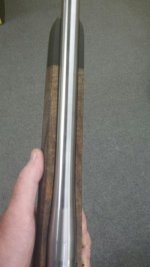Particularly with wood...it moves. Also, as we know, the barrel moves when fired, as do scopes. Ever seen a scope very close to a barrel? I've shown customers the mark on top of the barrel left by the scope and barrel coming into contact with each other, and still be able to slide a $ bill between the two, freely. The look on their face is one of enlightenment. The mark looks like a small wear mark. That has to be hard on optics but also tells us that stuff moves when a 60,000psi explosion happens in there.
Obviously, the person claiming on another site that the muzzle can only move about a half thou has never seen this and it raises question to his claim.
I've personally never liked the aesthetics of seeing a barrel channel large enough to encompass two barrels like I see on many benchrest rifles. I always chalked it up to them wanting absolute clearance no matter what barrel they swap to and that made plenty sense to me. I suppose it could be easy peace of mind with the barrel floating since there would be no question that a quarter inch of space is sufficient.
My bench rifle looks to have about thirty thousandths of an inch clearance between the channel and the barrel. Is that enough in your experience?
I'm not shocked about the scope movement. I've never had one so close to the barrel though.


